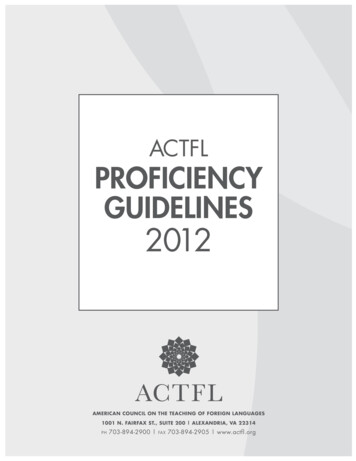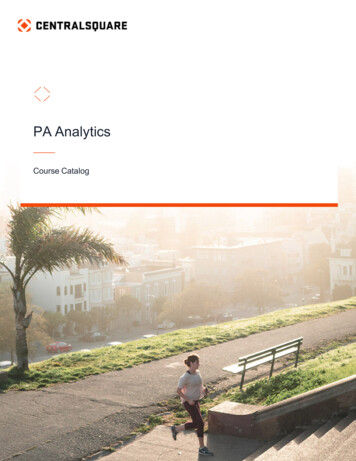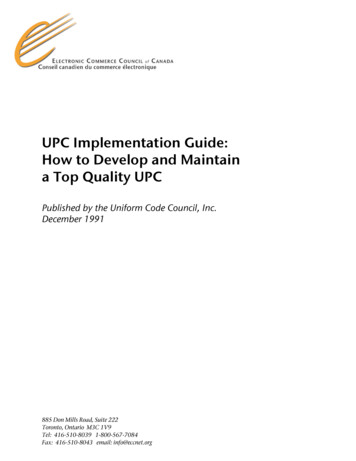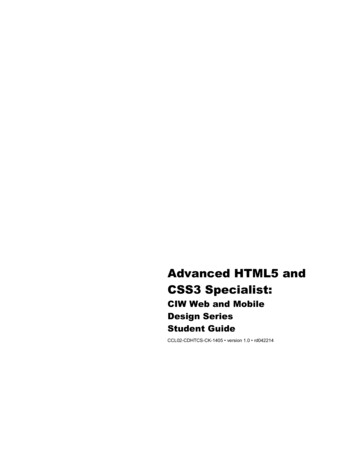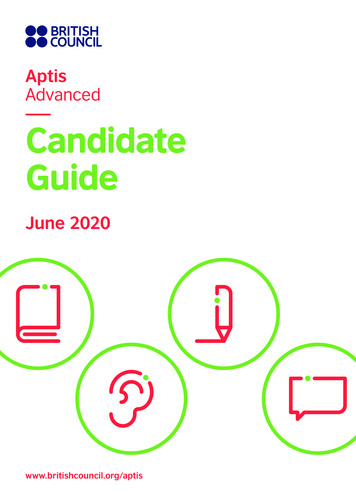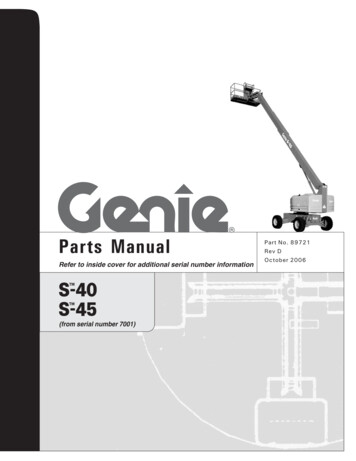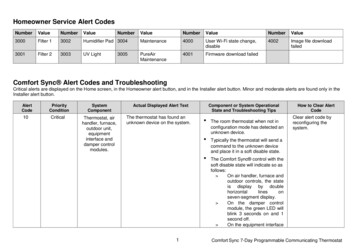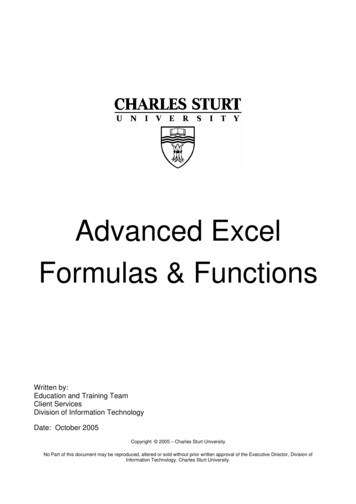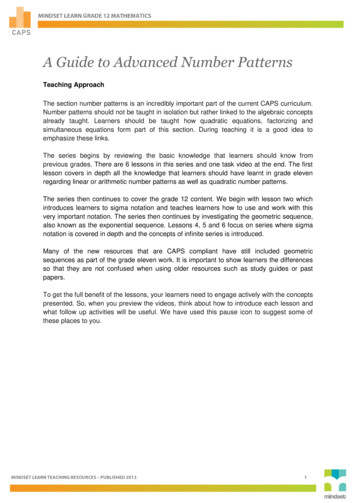
Transcription
A Guide to Advanced Number PatternsTeaching ApproachThe section number patterns is an incredibly important part of the current CAPS curriculum.Number patterns should not be taught in isolation but rather linked to the algebraic conceptsalready taught. Learners should be taught how quadratic equations, factorizing andsimultaneous equations form part of this section. During teaching it is a good idea toemphasize these links.The series begins by reviewing the basic knowledge that learners should know fromprevious grades. There are 6 lessons in this series and one task video at the end. The firstlesson covers in depth all the knowledge that learners should have learnt in grade elevenregarding linear or arithmetic number patterns as well as quadratic number patterns.The series then continues to cover the grade 12 content. We begin with lesson two whichintroduces learners to sigma notation and teaches learners how to use and work with thisvery important notation. The series then continues by investigating the geometric sequence,also known as the exponential sequence. Lessons 4, 5 and 6 focus on series where sigmanotation is covered in depth and the concepts of infinite series is introduced.Many of the new resources that are CAPS compliant have still included geometricsequences as part of the grade eleven work. It is important to show learners the differencesso that they are not confused when using older resources such as study guides or pastpapers.To get the full benefit of the lessons, your learners need to engage actively with the conceptspresented. So, when you preview the videos, think about how to introduce each lesson andwhat follow up activities will be useful. We have used this pause icon to suggest some ofthese places to you.
Video SummariesSome videos have a ‘PAUSE’ moment, at which point the teacher or learner can choose topause the video and try to answer the question posed or calculate the answer to the problemunder discussion. Once the video starts again, the answer to the question or the rightanswer to the calculation is given.Mindset suggests a number of ways to use the video lessons. These include: Watch or show a lesson as an introduction to a lesson Watch of show a lesson after a lesson, as a summary or as a way of adding in someinteresting real-life applications or practical aspects Design a worksheet or set of questions about one video lesson. Then ask learners towatch a video related to the lesson and to complete the worksheet or questions, either ingroups or individually Worksheets and questions based on video lessons can be used as short assessments orexercises Ask learners to watch a particular video lesson for homework (in the school library or onthe website, depending on how the material is available) as preparation for the next dayslesson; if desired, learners can be given specific questions to answer in preparation forthe next day’s lesson1. Revising Number PatternsIn this lesson we revise number patterns which display a constant difference and aconstant second difference between consecutive terms. Learners are taught how toidentify arithmetic or linear sequences as well as quadratic sequences.2. Using Sigma NotationIn this lesson we introduce the notation that denotes summation. Learners are taught howto use sigma notation and how to develop sigma notation.3. Arithmetic SeriesIn this lesson learners are taught how to identify arithmetic series and how to work withquestions involving arithmetic series. Sigma notation is introduced and learners areshown how to use this notation and more importantly how to interpret it.4. Investigating Geometric Number PatternsIn this lesson the focus is on teaching learners what a geometric sequence is and how toidentify geometric or exponential number patterns. Learners are shown how to solveproblems involving number patterns that lead to geometric sequences.5. Geometric SeriesIn this lesson learners are taught how to identify geometric series and how to work withquestions involving this series. Sigma notation is once again used and learners areshown how to use this notation and more importantly how to interpret it.6. Infinite Geometric SeriesIn this lesson learners are guided through an investigation to help them understand theconcept of diverging and converging series. In addition the lesson works questions withinfinite series that converge and diverge.
Resource MaterialResource materials are a list of links available to teachers and learners to enhance their experience ofthe subject matter. They are not necessarily CAPS aligned and need to be used with discretion.1. Revising Number ticket wZRXkSStB0A%3D&tabid 621&mid www.teachingideas.co.uk/maths/contents nopatterns.htm2. Using Sigma Notationhttp://www.youtube.com/watch?v meMJBqamL1E3. Arithmetic ources/uploaded/mc-ty-apgp-20091.pdf4. Investigating GeometricNumber Patterns5. Geometric es/geometric.htmlhttp://www.math.ufl.edu/ vatter/teaching/m8w10/m8l05.pdfThe web reference below is goodresources to use with weakerlearners who have not yetunderstood the concepts ofnumber patterns in earlier grades.This resource contains examplesand detailed solutions of linearpatterns and could be used bylearners who want more practiceor used by educators to developquick spot tests.The resource below containsgood theory notes on quadraticnumber patterns that could beused both by educators andlearners.This website below could exposelearners to other patterns thatexist in the real world but are notpart of the curriculum. One couldpossibly develop a project wherelearners use this resource topresent to their peers the differentpatterns that occur around usevery day.This is a video clip note on how touse sigma notation and how itlinks to series.These web references are goodresources to use as presentationsusing a data projector with weakerlearners who have not yetunderstood the concepts ofnumber patterns in earlier grades.This resource is best foreducators, it can be used to assisteducators when making notes fortheir learners of for the educatorwho wants to improve theirknowledge and understanding ofthis exciting topic.These are notes which you canwork through with weakerlearners who have not yetunderstood the concepts ofnumber patterns in earlier grades.Theory notes that cover contentand practice examples that canbe used as a recap lesson.This resource is best foreducators, it can be used to assist
6. Infinite Geometric //hotmath.com/hotmath help/topics/infinite-geometricseries.htmleducators when making notes fortheir learners of for the educatorwho wants to improve theirknowledge and understanding ofthis exciting topic.A revised lesson containing theoryand examples on infinite series.Best used as a consolidationlesson.
TaskQuestion 11.1 Determine the 15th term of the sequence: 5; 8; 11; 1.2 The sequenceis given. Calculate which term in the sequence is equal toQuestion 22.1 Determine which term of the sequence25; 14; 3; is equal to2.2 Calculate the value ofin the sequence9; 3; 1; Question 3The 1st term of an arithmetic sequence is 10 and the 6th term is 85. Calculate the first threeterms of the sequence.Question 4EvaluateQuestion 5Consider the pattern: 5; -2; -7;-10; 5.1 Write down the next two terms5.2 Determine an expression for the nth terms.5.3 Show that the sequence will never have a term with a value less than -11Question 6A tunnel is built by digging 1km each day. Each evening the workers return to their basecamp which was built at the starting point of the tunnel. After how many days will the workershave travelled a total of 1260km in the tunnel?Question 7The first term of an arithmetic sequence is 5 and the 6th term is ten times the 3rd term.7.1 Calculate the common difference7.2 Calculate the sum of the first 20 terms in this sequence.Question 8The first three terms of a convergent geometric series are:8.1 Calculate the value of8.2 Calculate the sum to infinity of the series
Task AnswersQuestion 11.11.2Question 22.1Term 8 is equal to – 522.2Question 3Question 4
Question 55.15.2-11; -105.3This is not true for any values of n thus the sequence will not have a term less than -11Question 6Question 77.17.2Question 88.1rTherefore K 3 as the ratio is half and will then converge
8.2AcknowledgementsMindset Learn Executive HeadContent Manager Classroom ResourcesContent Coordinator Classroom ResourcesContent AdministratorContent DeveloperContent ReviewerDylan BusaJenny LamontHelen RobertsonAgness MunthaliRaquel NeilsonHelen RobertsonProduced for Mindset Learn by TrafficFacilities CoordinatorFacilities ManagerDirector:Editor:Presenter:Studio CrewGraphics:Cezanne ScheepersBelinda RenneyAlriette GibbsNonhlanhla NxumaloBelinda RenneyJT MedupeAbram TjaleWayne Sanderson.This resource is licensed under a Attribution-Share Alike 2.5 South Africa licence. When using thisresource please attribute Mindset as indicated athttp://www.mindset.co.za/creativecommons
Mindset suggests a number of ways to use the video lessons. These include: Watch or show a lesson as an introduction to a lesson Watch of show a lesson after a lesson, as a summary or as a way of adding in some interesting real-life applications or practical aspects Design a worksheet or set of questions about one video lesson. Then ask learners to watch a video related to the lesson and to .


